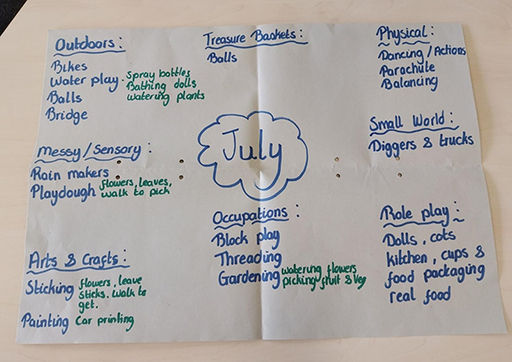1.2 Using and sharing observations and records
The information presented in Section 1.1 shows that it is possible to think that ‘observation’ is a more formal or organised term than watching or seeing, and that it’s something that professionals do – you could be in hospital ‘under observation’ but you wouldn’t be in hospital ‘being watched’. While it is true that we are more aware of undertaking a range of observations in a structured way when in the baby room, we do need to be aware that the fact ‘observations’ seem more formal can create a barrier where parents might be reluctant to share what they have ‘seen’ or ‘noticed’ while ‘watching’ their child, because those approaches are not as valued.
Making sure that you include the information that parents share with you in the records the setting keeps and making them a part of the observation portfolio, ensures a shared understanding of the child. Practitioners can do this by responding to comments that parents make in home/nursery diaries and by including the information in the displays and information that are on show around the setting.
Practitioners also need to make sure they use the information gathered from observations in a clear and organised way. An example of this is shown below, where the practitioners have captured children’s participation in activities by jotting information on sticky notes and putting these onto a piece of paper. These notes are snapshots of time that show what and how activities were played with, what the children were interested in, what questions they were asking, and lots of other issues. This information is then used to inform planning for the following month.

The mind map below was then developed using observations gathered from the sticky notes. This is done at the end of each week to inform the activities for the following week. In this example the writing in green has been added to show activities that have been included or extended as a result of observations taken throughout the preceding week.
When you have completed an observation, you need to use it to help you build up a picture of the child, so that you can support them to develop and progress. The diagram below outlines the kind of things that you should focus on noticing when building the picture, and shows what the next steps are.
To analyse the observations, it can be useful to have a set of key questions to work through. Doing that helps to make sure that you are considering the same factors every time, and this helps in identifying areas where there is lots of information and areas where there are gaps. Here are some example questions, but you can create your own too.
- What skills did we see the child use?
- What was the child interested in?
- Were there any other factors that might have affected what we saw (e.g. the weather, the time of day, the child’s health)?
- How does the information from this observation compare with previous ones?
- Is there anything I need to check or discuss with colleagues or the child’s parents as a result of this observation?
When you have analysed the information from the observations, you then need to think about how you are going to use it. There are lots of different ways this might be done, ranging from putting a note into the child’s record, to adding the observation to evidence for a referral to a specialist professional (like a speech therapist). The findings from your observation might show you that you need to do more observations to explain what is going on, or you might want to ask a colleague to look at the findings and ask their opinion. The important thing to remember is that all these elements are part of an ongoing process of observing, recording, analysing, responding and then observing again to ensure that the best learning experiences and support are being provided for all the children.


